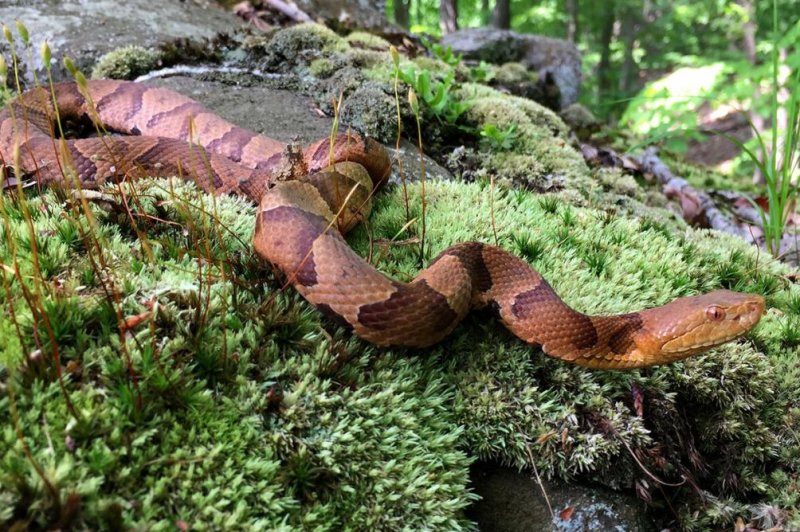After a five-year drought in a forest plot near Meriden, Conn., resident female copperhead snakes stopped reproducing. Photo by Chuck Smith
Oct. 29 (UPI) -- After several years of minimal precipitation, a population of copperhead snakes in a Connecticut forest stopped reproducing, according to a multiyear survey.
For several years, a team of scientists tracked the pregnancies of copperhead snakes living in a forest plot near Meriden, Conn. The survey spanned a five-year drought.
"Before this study, we knew surprisingly little about how drought directly affects reproduction in snakes," Mark A. Davis, a conservation biologist with the Illinois Natural History Survey at the University of Illinois, said in a news release.
Copperhead snakes must fatten themselves up for pregnancy. The first year of the survey followed the emergence of a massive brood of 17-year cicadas. Copperheads are known to stuff themselves on alternate food sources like cicadas. The summer after the feast, 20 female copperheads produced 148 young.
In 2012, the second year of the survey, the drought began. It lasted five years. Scientists weren't sure how the drought would influence the snakes' reproductive patterns -- whether they would produce fewer young or smaller young.
Because copperheads return to the same hibernation and gestation sites each year, tracking the population's reproductive success was relatively straight forward. Their observations showed the drop in precipitation resulted in fewer pregnancies.
Copperheads mostly eat tadpoles, salamanders and other small reptiles and amphibians, species that rely on water. As the drought persisted, there was less food for copperheads to eat.
"We saw that every year the drought wore on, there were fewer pregnant females, and the year after the drought ended there were no pregnant females at the site," Davis said.
In the first few years of the drought, some snakes continued to give birth, and those that did consistently birthed six snakes. The snakes were always the same size. In other words, the young didn't get smaller, and the moms didn't birth fewer snakes. But each year, fewer and fewer females gave birth.
"This means that the snakes are deciding, 'Do I have enough gas in the tank this year to produce offspring?'" Davis said. "And as the drought wore on, the answer was, increasingly, 'No.'"
The summer after the final year of the drought, just one female produced offspring. But the following years, precipitation levels returned to normal. The next summer, 16 pregnant females produced 100 young. Scientists confirmed that several of the females were snakes that they had recorded giving birth during the years prior.
The results of the multiyear survey -- published Tuesday in the journal Scientific Reports -- suggest copperheads are resilient but not immune to the effects of climate change. As prolonged droughts happen more frequently, declines in reproductive success could shrink otherwise resilient animal populations.
"This study shows that reproduction is complex," Davis said. "A changing climate coupled with the loss of biodiversity may be placing even common species at higher risk of declines in the short term and, perhaps, extinctions in the long term. This will only serve to erode those ecosystem services -- the benefits we receive from nature -- that these animals provide."















